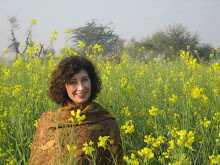
Some months ago I was looking through one of my many guidebooks on India. In one picture there was a field of flowers with deep green stalks and bright yellow blossoms. It was so beautiful. I hoped that one day I would be in that place.
Last February I was in "that place." The picture was that of mustard fields in bloom in Northern India. As it turned out, I went to visit Keoladeo Ghana National Park, a world renown bird and animal preserve in Bharatpur, Rajasthan, with my friend Regina.
We drove by field after yellow field before stopping. As I walked through the waist-high mustard plants I felt privileged to be there. The driver pulled a few golden blossoms from a stalk and rubbed them on my wrist. It turned slightly yellow and smelled sweet and gentle.
After a day of bird watching we returned to The Bagh, a resort in Bharatpur (http://www.thebagh.com/). To me, it's more like a little slice of heaven. The expansive grounds abound in fruit trees, flowering bushes, and plants that attract a huge variety of birds. Outdoor pavilions are perfect for lounging and bird-watching in the early mornings and evenings. We took advantage of the heated pool and had oily, relaxing Ayurvedic massages.
In the evening we sat in the elegant but homey bar enjoying gin and tonics and chatted about the birds and animals we saw, including a giant python sunning itself. We had worked up an appetite from our hard day of birding, head massages, and drinks and headed for the restaurant.
The food at The Bagh is divine, with specialty dishes of the region. Quite frankly, it is some of the best food I've had in India. We dined on a dishes with five types of dhal, minced lamb, spiced rice with tomatoes and chilies, and my favorite: fresh mustard greens with garlic. I could not have been happier.





